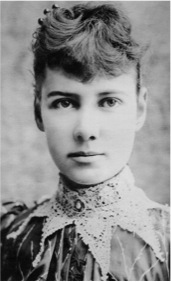 Nellie Bly, 1980. Photo Source: nellieblyonline.com Nellie Bly, 1980. Photo Source: nellieblyonline.com The investigative journalist most known by her pen name Nellie Bly, broke into the field by responding to a Pittsburgh Dispatch article titled “What Girls are Good For” in 1885. Despite its title, the article did not value the role of women outside the strict confines of the home. Instead, it reprimanded women for working and seeking education, and it stated that a woman’s place was in the home, only serving domestic duties and raising children. Bly, who was born with the name Elizabeth Cochran, wrote a letter to the editor in response to the article. Her response was so well received that it earned her a writing job at the Dispatch. With that, Cochran’s journalism career officially began under the name Nellie Bly. In the years to come, Bly became one of the best and most respected investigative journalists of the century. Where it all Began Bly was born in 1864 in Cochrane, Pennsylvania, a town named after her father, Judge Michael Cochran. Bly’s father died when she was only six years old. Her mother, Mary Jane Cochran, remarried to an abusive man, which led to a long and expensive divorce process. This left the family in financial hardship. Bly left home to attend Indiana Normal School with the hopes of becoming a teacher and earning wages. However, she had to return home after only one semester because she couldn’t afford tuition. At this time, Bly returned to Pittsburgh to help her mother. Just a few years later, Bly read and responded to the “What Girls are Good For” article and started her path as a journalist. The Women’s Pages Despite her talent, and inclination to pursue more hard-pressing news stories at the Pittsburgh Dispatch, Bly was limited -- like many female journalists at that time -- to reporting mainly for what were considered the, women’s pages. These pages consisted of articles concerning gardening, society, fashion, lifestyle and so forth. Bly did convince the paper to send her to Mexico for several months in 1886 and 1887 where she served as a foreign correspondent and reported on the country’s corruption and the state of the poor. Her articles were later published in the collection Six Months in Mexico in 1888. However, upon returning to Pittsburgh, Bly was, once again, assigned to stories for the women’s pages. Proving Her Value and Worth In 1887, Bly left Pittsburgh for New York City, where she was determined to find a role at a major newspaper. However, after four months, she faced only rejections and was completely broke. Undefeated, Bly convinced her way into the office of John Cockerill, managing editor of The New York World, Joseph Pulitzer's paper. She landed herself a role with a challenging first assignment. What was Bly’s first assignment at the World? Get herself committed into an insane asylum on Blackwell’s Island (now Roosevelt Island) by pretending to be insane. Bly’s first task for The World resulted in a published exposé of the patients’ living and treatment conditions. Bly’s investigative work promoted investigation and reforms within the institution. The full collection was also published as Ten Days in a Mad House in 1887. Bly is considered one of the early muckrakers. While working at The World, Bly’s investigative reporting also exposed ill conditions and corruption in sweatshops, legislatures and jails. By digging in and exposing the actual conditions, Bly was able to open up people’s eyes to the necessary reforms needed. International Fame In 1889, Bly set sail to create a sensation that attracted international audiences and made her famous around the world. Bly chronicled her journey to beat the record of Jules Verne’s fictional character Phileas Fogg, who traveled Around the World in 80 Days. (Fun fact: During her time in France, Bly ran into Verne, who encouraged her to succeed in breaking his fictional record.) Bly’s journey prompted a huge guessing contest hosted by The World and brought the paper increased profit. Bly succeeded in her quest; she clocked 72 days 6 hours 11 minutes 14 seconds. In 1890, her accounts were published in Nellie Bly’s Book: Around the World in Seventy-two Days. Bly’s Later Years In 1895, Bly married millionaire Robert Seaman, owner of Iron Clad Manufacturing Company. A year later, Bly stopped writing for The World, but she became involved in the running of her husband’s company. When her husband passed away in 1904, Bly took full ownership of the company. In the years that followed, Bly experienced personal, company and financial woes. In 1914, Iron Clad went bankrupt. Later that year, Bly visited her friend in Austria and saw the outbreak of World War I. After reaching out to a former World editor, Arthur Brisbane, who at this point now worked at The New York Evening Journal, Bly made preparations to again become a journalist. Bly was one of the first American female war correspondents. She wrote about her experiences on the frontline for five years. After the war, Bly returned to New York and continued to write regularly for The New York Evening Journal. In 1922, Bly died of pneumonia. The day after her death, The Evening Journal published a tribute to Bly declaring her, “The Best Reporter in America.” Throughout her life, Bly pushed the boundaries, giving voice to the voiceless. By Lisa Zimmermann
0 Comments
Your comment will be posted after it is approved.
Leave a Reply. |
Archives
July 2017
Categories
All
|
 RSS Feed
RSS Feed